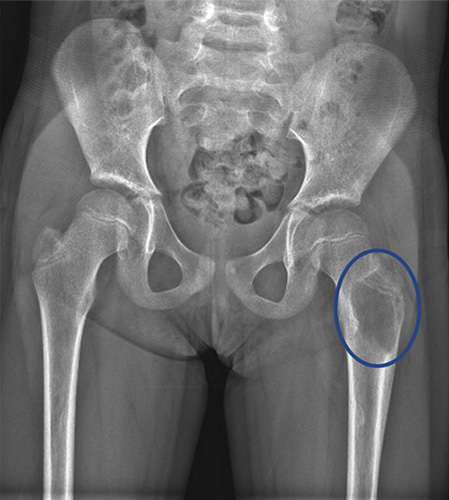Benign Bone Tumor
- What is a benign bone tumor?
- Who gets benign bone tumors?
- How are benign bone tumors diagnosed?
- How are benign bone tumors treated?
What is a benign bone tumor?
A benign bone tumor is an abnormal lesion in the bone which is identifiable on an X-ray or other type of radiological imaging and affects the architecture of the bone. This type of tumor (meaning abnormal growth of tissue), it is not cancerous because it does not have the capacity to grow into or cause damage in other parts of the body.
Common benign bone tumors include non-ossifying fibromas, osteoid osteoma, osteochondroma, enchondroma, chondroblastoma and osteoblastoma. Other conditions of abnormal bone that can look and behave like benign tumors include fibrous dysplasia, bone cysts and ganglion cysts.

Anteroposterior (front-to-back) X-ray view of a benign bone tumor in the left upper femur (thighbone) of a six-year-old child. The type of tumor in this image is an aneurysmal bone cyst.
Who gets benign bone tumors?
Benign bone tumors commonly develop while a person is still growing, so the majority are diagnosed in children and adolescents. Some benign tumors are inherited through families, like multiple osteochondromatosis, but the majority are spontaneous growths, and it is usually not known why one person develops a tumor while another does not. It is difficult to know how many people are affected because many people never seek treatment for lesions that are not causing any symptoms.
How are benign bone tumors diagnosed?
The initial discovery of a benign bone tumor is usually on an X-ray, which may have been obtained for a completely separate reason, but which reveals a bone lesion nonetheless. Many benign bone tumors and lesions have a particular appearance on X-ray, so no further studies are needed to make a predictive diagnosis. Some benign tumors require a CT scan or MRI to be obtained, both to aid in the diagnosis and to plan treatment. The final step in making a definitive diagnosis is with a biopsy. While the majority or benign bone tumors do not require a biopsy, some look similar enough to a malignant cancerous tumor to require this procedure. However, once a benign diagnosis is made, treatment can often proceed during the same operation.
How are benign bone tumors treated?
There is a wide spectrum of treatment for benign bone tumors which depends on the specific diagnosis. Some tumors are indolent or quiescent, meaning they are stable in the bone and unlikely to cause problems. They can be followed over time but do not require surgery. Other tumors are more active and require surgical removal of the abnormal tissue to stop their growth and allow normal bone to fill the space previously occupied by the tumor. Other benign tumors are aggressive and may have already destroyed a substantial amount of bone prior to treatment. These require a longer surgery to both remove the tumor as well as stabilize the remaining healthy bone with an orthopedic implant (plate, screws, nail, etc.). Some tumors, despite being benign, can recur in the same area, so close follow up with your surgeon over time is important.
Articles related to bone tumors
Posted: 10/7/2020
Reviewed and edited by Taylor J. Reif, MD

